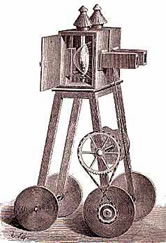 This particular picture of Elizabeth was shot by David Octavius Hill and Robert Adamson
This particular picture of Elizabeth was shot by David Octavius Hill and Robert AdamsonElizabeth was not a photographer she was a writer about photographer. She was often photographed by Hill and Adamson.
::Elizabeth (Rigby) Eastlake::
• Born as Elizabeth Rigby on November 17, 1809
• British Author, art critic and historian
• First woman to write on a regular basis for Quarterly Review
• Known for writing and having a part in the London art world
• Husband was Sir Charles Eastlake and directed the National Art Gallery in London
• Born in Norwich by Edward and Anne Rigby
• At a young age Elizabeth enjoyed drawing and began studying art in her early twenties
• Elizabeth had a private education : Learned French and Italian
• 1827 she had an illness which pushed her to convalesce in Germany and Switzerland.
• Started a publication translating Passavant’s essay which was about English art.
• 1835 Elizabeth took trip number 2 to Germany which led her to Goethe another article.
• She then visited her married sister and went on to publish her articles and her book A Residence on the Shores of the Baltic in 1841
• Elizabeth had a literary career which led her to an intellectual social circle with people like Lord Jeffery, John Murray and David Octavius Hill
• They photographed her in twenty early calotypes Robert Adamson Assisted
• 1857 Elizabeth published an article that showed the relationship between art and photography
• At 40 Elizabeth married Sir Charles Eastlake
• She travel a lot through the 1850’s and 60’s while doing that they toured European countries to get new acquisitions for the gallery
• Was a huge part in popularizing German art history in England
• By being a Critic and translator
• Husband past away in 1865
• Wrote Five Great Painters in 1883 (Leonardo da Vinci, Michelangelo, Titian, Raphael and Durer)
• Elizabeth basically made the way for females in journalism
• She died in 1893
http://www.photokaboom.com/photography/pdfs/Lady_Eastlake.pdf
Short bio















 This is a video of Keith Carter and he is talking about his photography and his methods of photography.
This is a video of Keith Carter and he is talking about his photography and his methods of photography.









 in the beauty of a building is quite the task. Not only does he nail the composition but the lighting of the photographs are magnificent. Repeating shapes a prevalent in his work and he has several nationally acclaimed photographs.
in the beauty of a building is quite the task. Not only does he nail the composition but the lighting of the photographs are magnificent. Repeating shapes a prevalent in his work and he has several nationally acclaimed photographs.



















